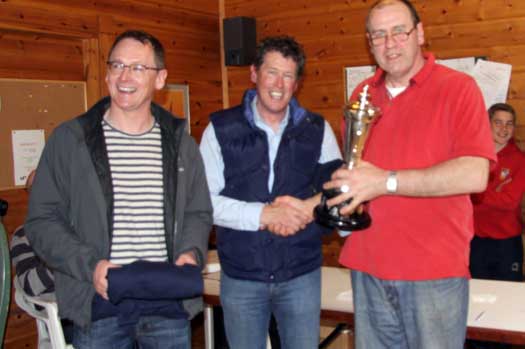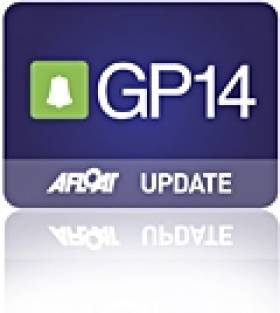Displaying items by tag: Lough Owel
Warning Over Low Water Levels For Navigation On Royal Canal
#RoyalCanal - Waterways Ireland is advising masters and users of the Royal Canal that due to unprecedented dry weather conditions and low rainfall levels and subsequent low levels in Lough Owel, navigation water levels cannot be guaranteed on certain sections of the canal, particularly the summit level and adjacent levels.
Masters should contact the local water patroller prior to any planned journey along this inland waterway.
Suspected Outbreak Of Crayfish Plague In Lough Owel
#Crayfish - The National Parks and Wildlife Service (NPWS) is investigating the widespread deaths of white-clawed crayfish in Lough Owel that may be linked to an outbreak of crayfish plague.
As TheJournal.ie reports, the Co Westmeath inland waterway is home to a large population of the endangered marine species, which have never before tested positive for the plague.
Samples are being tested by the Marine Institute’s Fish Health Unit — which recently investigated an outbreak of carp edema virus in Cork — with the first results due in days.
The most recent outbreak of crayfish plague was last Autumn in the River Barrow, following incidents in North Tipperary. Ireland was considered free of the disease before 2015.
TheJournal.ie has more on the story HERE.
#gp14 – The GP14 Leinster's hosted by Mullingar SC on lovely Lough Owel in Co. Westmeath had a great entry of 36 boats from 15 clubs, from Moville in Donegal to Youghal in Cork writes Norman Lee. The tide was in so parking spots were at a premium on Saturday morning when we all rocked up but that meant deeper water for sailing thanks to the rain gods.
Saturday's 3 races in strong gusty winds had 3 different winners from different clubs. The first went to John/Donal Mc Guinness of Donegal the second to Shane Mc Carthy/Damian Bracken of Wicklow and the third to Niall Henry /Ossian Geraghty of Sligo. Large Olympic triangle courses mixed tough tacticle beats with fast planeing reaches and tactical runs and places changed regularly through the fleet with Bronze, Silver and Gold boats mixing it up.
Satisfied and tired after our exertions we all retired to the Park Hotel for a 5 star BBQ and to watch Leinster scrape by Ulster and witness the launch of a great new book on the history of MSC. There was a good band on too but it didn't get many takers from the tired legged sailors discussing the days fun.
Sunday dawned damp and dismal but it dried and the wind picked up as we all went afloat.
Three good light and tactical races were completed with interesting port biased starts and big shifts to catch out the unwary. 2 new winners popped up in search of the trophy, Paddy O Connor/ Colm O Flaherty of Sligo grabbed the first convincingly followed by Ger Owens/Melanie Morris of Dublin and Belfast taking the next 2 seeming to put them in contention but they and others got tripped by the black flag allowing the first race winners, the McGuinness brothers from Moville to be crowned Leinster Champions with their high 15.75 tally showing the competitive nature of the fleet.

Donal (left) and John McGuinness (centre) receive their Leinster prizes from the Mullingar Sailing Club Commodore
Tough competition in the Silver fleet say Rob Lee/ Troy Dmc NAmara of Greystones in 19 yr old 13403 triumph over Simon Cully / Libby Tierney of Blessingtonin 0 yr old 14138 - they finished a creditable 7th and 11th overall.
Local man returned fro Canada Andy Van beck won the tussle for Bronze from newbies Simon/ Rebecca Jefferys of East Down and Adrian Lee Arne Edward Coyne of Youghal.
This was a great warm up for tihe Irish fleet in preparation for the Worlds in Strangford Lough in August – roll on the Ulsters in June and the Nationals in July.
Additional reportage from GP14 class:
The Leinster Championships had an early start this year but this didn't put off enthusiasm with 36 boats showing up in Mullingar to contest in the breezy conditions. At the briefing we had a minutes silence to remember Graham Elmes,a life-long sailor and a good friend of many in the fleet who very sadly passed away earlier in the week.
Beautiful sunshine with a solid force 4 gusting 5 made for very exciting sailing and Shane Mac Carthy & Damian Bracken showed their class by taking the opener followed by Sutton pair Alan Blay & David Johnston in second and Niall Henry & Ossian Geraghty in their new boat in third.
The second race was won by Niall & Ossian with the McGuinness brothers in second and Shane & Damian in third. The McGuinnesses then won the third race after a tussle up the last leg to beat Shane & Damian with Niall & Ossian in third.
Things were fairly tight after the breezy first day with the 3 boats very tight on points but Shane & Damian had a small advantage, thanks in no small part to 24 months of year round training and dieting. Keith Louden & Alan Thompson were also rumoured to be considering giving up the drink in preparation for the Worlds after watching their performance. Niall & Ossian will also have been happy to put gear failure in Swords behind them and show a real turn of pace in their new boat. As always in Mullingar there was a great social aspect with everyone back to the town and a great bar-b-que with very solid portions appreciated by all.
The following day we all awoke to rain and light winds, a complete contrast to the day before.
This was the day for Ger & Melanie to shine and we all knew it and they didn't disappoint. They had been carrying 2 fourths and a DNF from the windy day and had a lot of ground to make up. The first race had a general recall and subsequent black flag which made the start tense. Paddy O'Connor under instruction from crew Colm O'Flaherty got the favoured pin and then got a shift on the left to get away and won the race from Ger & Melanie and Keith Lauden & Alan Thompson (light wind specialists). The next race was won very easily by Ger & Melanie with Alan & David in second and Colman Grimes & David Lappin in third. Ger & Melanie cruised home in the last also with blistering speed followed again by Alan & David and with the McGuinness brothers in third and Rob Lee & Troy McNamara from the silver fleet in fourth
As we went ashore it was generally considered that Ger &Melanie had done enough as all 3 first day leaders had tripped up at various stages in the light conditions but there was a surprise in store. When the results were posted it showed a black flag DSQ for them and with the first day retiral to count, this took them out of the reckoning.
In the end the trophy went back to the sailors from Donegal in their new boat with Shane & Damian in second and Paddy & Colm in third
Rob Lee & Troy McNamara took the silver fleet with Simon Cully & Libby Tierney in second (despite very thin jib sheets) and Grahame & Rebecca Farrington in third. Andy Vanbeck honoured us with his presence from Canada and won the bronze fleet with rock star crew Nigel Sloan. Simon & Rebecca Jeffery finished second in the bronze fleet and Adrian Lee & Edward Coyne in third.
Overall Results:
Gold Fleet:
1. John & Donal McGuinness
2. Shane MacCarthy & Damian Bracken
3. Paddy O'Connor & Colm O'Flaherty
Silver Fleet:
1. Rob Lee & Troy McNamara
2. Simon Cully & Libby Tierney
3. Grahame & Rebecca Farrington
Bronze Fleet:
1. Andy VanBeck & Nigel Sloan
2. Simon & Rebecca Jeffery
3. Adrian Lee & Edward Coyne


























































